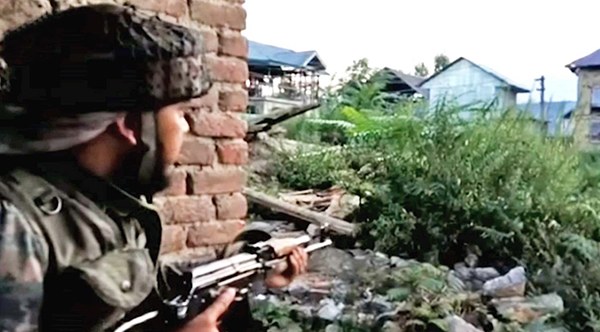
Riyaz Naikoo, alias Mohammad Bin Qasim, a wanted-militant and also the chief of operations of the Hizbul Mujahideen (HuM), evading arrest for last eight years died a dog’s death at the hands of the Indian security forces on 6 May in his native village of Beighpora in the southern Pulwama district.
With Naikoo, who carried a reward of Rs 12 lakh on his head, two other terrorists were killed in a separate encounter in Sharshali Khrew area of Awantipora on 5 May.
Six months of persistent surveillance and the arrest of a mason, who reportedly built HuM commander Riyaz Naikoo’s hideout, led the forces to the big catch. A cordon and search operation had been carried out after the security forces were tipped off about the presence of militants in Beighpora area.
Mobile internet services were suspended in Kashmir as a precautionary measure. Soon after the incident, stone pelting broke out in the area following which cellular services were also shut.
Naikoo had taken over the HuM leadership in the Valley from Mohammad Yasin Itoo, alias Mehmood Ghaznawi, after he was killed in August 2017 in a gunfight in Shopian’s Awneera. Before Ghaznawi, Burhan Wani, the poster boy of militancy in the Valley, was killed in July 2016.
Naikoo’s killing is a significant blow to pro-Pakistan group HuM. It also marked an end of an era in which a generation of militants, like Burhan Wani and Zakir Musa, evoked folklore popularity and gained an unprecedented support and sympathy. It also proved that the shelf life of terrorists in J&K was few months. None of the surviving commanders and cadres has been able to step forward.
The reversals began in autumn of 2018 when dozens of district-level commanders were killed in precise anti-insurgency operations that dramatically dented the capabilities of the militant groups.
Nearly 800 militants – most of them locals, ill-trained and ill-equipped – have been killed in last four years and during the first half of 2020.
Saifullah Mir, aka Qasim Haider, a resident of Malangpora in Pulwama and part of the Burhan Wani group of 12 terrorists, listed as a A++ category terrorist, is reported to have succeed Riyaz Naikoo to fill the void in the group. A medical assistant in the past, he has treated terrorists wounded in encounters with the security forces.
Saifullah began as a guide for terrorists in Pulwama, Tral, Kakapora and Kulgam areas. He has been active in Srinagar city as well.
On the killing of Naikoo, the Chief of Defence Staff (CDS), Gen Bipin Rawat remarked, “The priority of the Armed Forces is to always get after the terrorist leadership and neutralize them as fast as possible. If you succeed in doing so, recruitment levels go down. They are not able to spread violence among the people because it is the leadership that spreads all the violence amongst the people and coerces the local population-young boys and girls through misinformation and they try to encourage them to join more often than not through fear and coercion. So if we are able to eliminate leadership, we are quite hopeful that you will find that recruitment will come down and there will be lesser violence in the Valley. It has always been the effort of the Armed Forces and they will continue doing so.”
“Creating a more than life-size image of a terrorist leader is somehow propagating them into this Rambo kind of image. I think the more we stay away from them and highlight their negativity more, we will not create this Rambo image of these people. They are people just spreading terrorism, mayhem, and not allowing normalcy to return in the state. They are not heroes in the eyes of the local population. People are being coerced to treat them as heroes because of social media,” the CDS opined on attempts to build a larger than life image of Riyaz Naikoo.
The Resistance Front Launched
The Resistance Front (TRF), a new terror group has been rushed by Pakistan to take responsibility for major terror attacks and firefights in Jammu & Kashmir. It is controlled by three top handlers of the Lashkar-e-Taiba (LeT) in Pakistan – Sajad Jatt for South Kashmir, Khalid for Central Kashmir and Hanzala Adnan for North Kashmir.
The TRF was launched in late 2019 after Parliament scrapped Jammu & Kashmir’s special status and divided the state into two centrally-administered union territories, Ladakh and Jammu and Kashmir.
The exercise is designed to give terror in Kashmir an indigenous face to ward off international pressure, particularly from the anti-terror financing watchdog Financial Action Task Force (FATF), over Pakistan sponsoring Islamist terror groups and what New Delhi describes as its jihadi terror factories.
This objective reflected the choice of names for the Inter Services Intelligence’s (ISI) recent terror initiatives such as TRF or the low-key JK Pir Panjal Peace Forum. These names do not have a religious label but suggest that they are homebred.
It is a facade to help the terror group gain space in the public mind and to attract local recruits. LeT’s old guard was focussing on getting TRF new recruits from the Kashmir Valley.
TRF’s social media managers in Pakistan claimed responsibility after five terrorists and an equal number of army soldiers were killed in the Keran sector in early April. The group also claimed responsibility for the gunfight in north Kashmir’s Handwara town that killed five security men, including the commanding officer of a Rashtriya Rifles battalion and a Major on 3 May.
TRF is expected to carry out grenade attacks, mostly using its overground workers or fresh recruits rather than risking its trained hands. The group, however, lost dozens of grenades when the police caught some of its overground workers ferrying arms and ammunition in March.
Comments
The elimination of Riyaz Naikoo was a result of developing actionable human intelligence and operational synergy among forces fronting the counter-terror operations.
The Special Operations Group of the Jammu & Kashmir Police had been working on people in the Kupwara district who had access to Riyaz Naikoo. One of them was a man who had played a role in building the secret bunker in his native village in south Kashmir’s Pulwama. The intelligence was pinpointed.
Riyaz Naikoo’s elimination, a serious setback to terror group HuM in south Kashmir, is considered one of the most successful security operations in recent months in Jammu & Kashmir.
Even Syed Salahuddin, the Hizbul founder, who also leads the Pakistan’s ISI-backed alliance of terror groups – United Jihad Council – said the “the enemy (India) has the edge”. A day after Naikoo’s killing, he could be heard saying, “It’s a shock for all of us (killing of Riyaz Naikoo) but these ‘shahadats’ (sacrifices) are going on in Kashmir since long. Since January this year 80 Mujahideens (terrorists) have given their ‘Shahadat’ (eliminated by the security forces) and all of them were highly educated and trained.”
The security forces have now concentrated on spotting every terrorist infiltrating from Pakistan, analysing infiltration routes to spot gaps in counter-infiltration grid along the LoC, focusing on human intelligence, and stepping up offensive against foreign terrorists in Kashmir Valley.
Pakistan, by all accounts, is determined to bear down on India. This is the first summer after India scrapped Jammu & Kashmir’s special status in August 2019 and Islamabad has been prepping ever since.
It was clear that the Deep State was clearly in-charge of Pakistan’s Kashmir policy. And Imran Khan, quite like India had anticipated right in the beginning, was letting the army run the show.
Imran Khan’s tweets on Kashmir had attributed violence in Kashmir to an “indigenous resistance movement” and accused India of finding a pretext to launch a “false flag operation.” This remark has been interpreted in New Delhi to imply that the TRF model of funding terror and denying a role in terrorism in Kashmir was the template.
=================
Riyaz Naikoo’s Bad Deeds
Riyaz was involved in:
• Killing of Haji Ghulam Mohammad Dar, father of a sarpanch, at Dogripora on March 8, 2014
• Firing on a police bus near Bhatpora Tokena
• Killing of Gh Mohi-Ud-din Dar
• Killing of Javaid Akbar Khanday, resident of Khandaypora
• Killing of police Head Constable Ashiq Hussain Mir at the Padgampoara crossing
• Kidnapping of Constable Naseer Ahmad
• Looting of nine weapons from the residence of former MLA Wachi
• Killing of six migrant labourers in Kulgam
• Killing of truck drivers and fruit traders post August 5, 2019
• Release of an audio tape threatening attacks on the jail staff after preferential treatment being provided to militants and separatists lodged in various jails was discontinued.

















